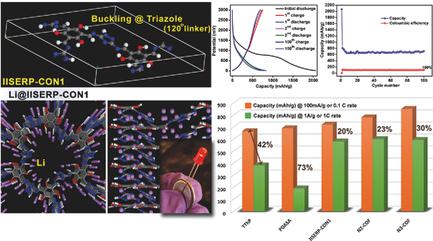当前位置:
X-MOL 学术
›
Adv. Energy Mater.
›
论文详情
Our official English website, www.x-mol.net, welcomes your
feedback! (Note: you will need to create a separate account there.)
High and Reversible Lithium Ion Storage in Self‐Exfoliated Triazole‐Triformyl Phloroglucinol‐Based Covalent Organic Nanosheets
Advanced Energy Materials ( IF 24.4 ) Pub Date : 2017-11-24 , DOI: 10.1002/aenm.201702170 Sattwick Haldar 1 , Kingshuk Roy 1 , Shyamapada Nandi 1 , Debanjan Chakraborty 1 , Dhanya Puthusseri 1 , Yogesh Gawli 2 , Satishchandra Ogale 3, 4 , Ramanathan Vaidhyanathan 1, 4
Advanced Energy Materials ( IF 24.4 ) Pub Date : 2017-11-24 , DOI: 10.1002/aenm.201702170 Sattwick Haldar 1 , Kingshuk Roy 1 , Shyamapada Nandi 1 , Debanjan Chakraborty 1 , Dhanya Puthusseri 1 , Yogesh Gawli 2 , Satishchandra Ogale 3, 4 , Ramanathan Vaidhyanathan 1, 4
Affiliation

|
Covalent organic framework (COF) can grow into self‐exfoliated nanosheets. Their graphene/graphite resembling microtexture and nanostructure suits electrochemical applications. Here, covalent organic nanosheets (CON) with nanopores lined with triazole and phloroglucinol units, neither of which binds lithium strongly, and its potential as an anode in Li‐ion battery are presented. Their fibrous texture enables facile amalgamation as a coin‐cell anode, which exhibits exceptionally high specific capacity of ≈720 mA h g−1 (@100 mA g−1). Its capacity is retained even after 1000 cycles. Increasing the current density from 100 mA g−1 to 1 A g−1 causes the specific capacity to drop only by 20%, which is the lowest among all high‐performing anodic COFs. The majority of the lithium insertion follows an ultrafast diffusion‐controlled intercalation (diffusion coefficient, DLi+ = 5.48 × 10−11 cm2 s−1). The absence of strong Li‐framework bonds in the density functional theory (DFT) optimized structure supports this reversible intercalation. The discrete monomer of the CON shows a specific capacity of only 140 mA h g−1 @50 mA g−1 and no sign of lithium intercalation reveals the crucial role played by the polymeric structure of the CON in this intercalation‐assisted conductivity. The potentials mapped using DFT suggest a substantial electronic driving‐force for the lithium intercalation. The findings underscore the potential of the designer CON as anode material for Li‐ion batteries.
中文翻译:

自剥落的三唑-三甲酰基间苯三酚基共价有机纳米片中的高可逆锂离子存储量
共价有机骨架(COF)可以成长为自剥落的纳米片。它们的石墨烯/石墨类似于微观结构和纳米结构,适合电化学应用。在这里,介绍了共价有机纳米片(CON),其内衬有三唑和间苯三酚单元的纳米孔,它们都不能牢固地结合锂,并且它具有作为锂离子电池阳极的潜力。它们的纤维质地使纽扣电池阳极易于合并,并表现出约720 mA hg -1(@ 100 mA g -1)的极高比容量。即使经过1000次循环,它的容量也得以保留。电流密度从100 mA g -1增加到1 A g -1导致比容量仅下降20%,在所有高性能阳极COF中最低。锂的大部分插入遵循超快扩散控制插层(扩散系数,D Li + = 5.48×10 -11 cm 2 s -1)。密度泛函理论(DFT)优化的结构中不存在强力的Li骨架键,支持了这种可逆插值。CON的离散单体显示的比容量只有140 mA hg -1 @ 50 mA g -1而且没有锂嵌入的迹象表明,CON的聚合物结构在这种嵌入辅助电导率中起着至关重要的作用。使用DFT测绘的电势暗示了锂嵌入的强大电子驱动力。这些发现强调了设计师CON作为锂离子电池负极材料的潜力。
更新日期:2017-11-24
中文翻译:

自剥落的三唑-三甲酰基间苯三酚基共价有机纳米片中的高可逆锂离子存储量
共价有机骨架(COF)可以成长为自剥落的纳米片。它们的石墨烯/石墨类似于微观结构和纳米结构,适合电化学应用。在这里,介绍了共价有机纳米片(CON),其内衬有三唑和间苯三酚单元的纳米孔,它们都不能牢固地结合锂,并且它具有作为锂离子电池阳极的潜力。它们的纤维质地使纽扣电池阳极易于合并,并表现出约720 mA hg -1(@ 100 mA g -1)的极高比容量。即使经过1000次循环,它的容量也得以保留。电流密度从100 mA g -1增加到1 A g -1导致比容量仅下降20%,在所有高性能阳极COF中最低。锂的大部分插入遵循超快扩散控制插层(扩散系数,D Li + = 5.48×10 -11 cm 2 s -1)。密度泛函理论(DFT)优化的结构中不存在强力的Li骨架键,支持了这种可逆插值。CON的离散单体显示的比容量只有140 mA hg -1 @ 50 mA g -1而且没有锂嵌入的迹象表明,CON的聚合物结构在这种嵌入辅助电导率中起着至关重要的作用。使用DFT测绘的电势暗示了锂嵌入的强大电子驱动力。这些发现强调了设计师CON作为锂离子电池负极材料的潜力。









































 京公网安备 11010802027423号
京公网安备 11010802027423号